1960s fashion was unlike any other decade because the clothing was as revolutionary and fast-moving as the era’s sweeping social, political and cultural changes.
It’s thanks to 1960s fashion that women are wearing everything from skirts above the knee to knee-high boots; empire waists to “no waists” and leopard print to printed stockings. And as unbelievable as it sounds, without the boundary-pushing fashion inventions of the ’60s, today’s woman would be unable to purchase a pair of formal pants.
Just like the changes of the ’60s themselves, the clothing trends were similarly groundbreaking and for the most part, completely new and novel ideas to the landscape of fashion.
While ’60s designers still defined trends for the season, for the first time ever counterculture groups like London’s “mod” scene and America’s “hippie” sect influenced the styles and clothing types produced by mainstream fashion brands and marketed to the decade’s youth.
<< SHOP NOW: Authentic & awesome 1960s vintage clothing from eBay!
But what’s most important is that the style inventions of the ’60s paved the way for today’s trends. In other words, 1960s fashion influences can be seen in contemporary fashion, especially as seen on 2010’s ’60s fashion-inspired runway designs for spring. That’s why any modern woman can wear vintage clothing: Because it’s thanks to the trends of the past that we have the fashion of today.
Keep reading after the jump for the history of 10 trends that literally rocked the fashion world and defined ’60s clothing as some of the most revolutionary ever to hit the stores.
1960s Style Dresses from Shabby Apple
The ’60s is remembered for laying the seeds of change which would eventually grow and blossom to accomplish groundbreaking goals in the ’70s. It was thanks to the decade’s general “Let’s get on with the future” attitude that the Western world decided it no longer wished to be stuck in its old ways — both politically, socially and fashionably.
Fashion lovers, I encourage you not to be stuck in your old fashion ways! Start a revolution and wear vintage style today. Because who knows? You might just start a few trends of your own!
Let me know what clothing invention of ’60s fashion surprised you most by leaving me a comment below the post!
If I missed a ’60s clothing trend you love, let me know by saying hello on Facebook, Twitter or Email!
xx, SD
’60s FASHION TRENDS
Feel free to scroll through the post to learn all about trends invented in the ’60s that have influenced fashion today, or click any of the links below to be taken immediately to the text within the article!
#1: Mini Skirts
#2: Leopard Print
#3: Bell Bottoms
#4: Knee-High Boots
#5: The Empire Waist
#6: No Waist
#7: Tuxedo “Le Smoking” Jacket
#8: The Pantsuit
#9: Military Style
#10: Patterned Tights
MINI SKIRT
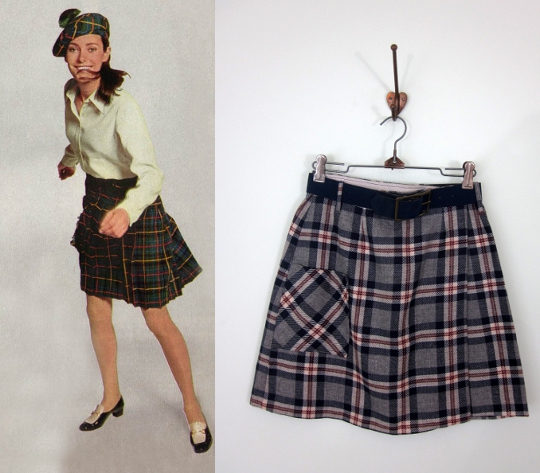 Credit: Fashion-pictures.com
Credit: Fashion-pictures.com
THE TREND: The miniskirt, characterized by a hemline which fell a few inches above the knee (or shorter, if you dared!)
ITS INVENTION: Records state that the miniskirt was first introduced to fashion buyers by French designer André Courrèges in 1964. The above-the-knee skirt was such a novel idea for the time that it was ill-received and not placed in stores for the season.
It would take a British designer named Mary Quant to give the new hemline a name (she named it after her favorite car, the British “mini”) and to give it the marketing momentum it needed to reach the mainstream.
Rather than show the miniskirt to old school fashion buyers, Mary went where the trends were born and onto the mod-culture-immersed streets of London where men and women were already pushing the boundaries of fashion and laying claim to the art of self expression.
Beginning in 1966 every Pretty Young Thing on Kings Road (one of London’s most famous fashion districts) was showing just how sexy the skin above her knee cap could be.
While both André Courrèges and Mary Quant claim that they invented the mini, other records state that John Bates also influenced birth of the idea. Bates was the main designer for UK spy series The Avengers, a show in which the male detective is surrounded by hot female assistants oftentimes costumed to show more skin than smarts.
While Courrèges and Bates may have predicted the future of the skirt, it was Quant that put the “mini” on the market.
ITS INFLUENCE: Every girl reading this right now owns or has owned a miniskirt of her own. Whether it’s formal, fun or funky there’s a style for every woman. The miniskirt undoubtedly influenced the rise in hemline for all of fashion.
Without the birth of the mini, there’d be no Daisy Dukes, hot pants, schoolgirl skirts, babydoll dresses and definitely not a pair of cut-off denim in sight.
The mini was a small piece of fashion that metaphorically speaking, was the biggest idea of its time.
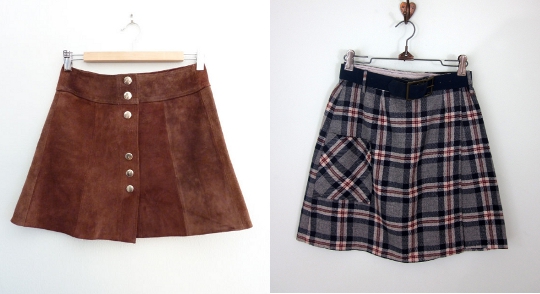
BUY THEM NOW: ’60s Brown Suede Mini Skirt by Sainte Marie Vintage on Etsy, $28 / ’60s Plaid Mini Skirt by Sally Jane Vintage on Etsy, $26
[Back to the top.]
LEOPARD PRINT
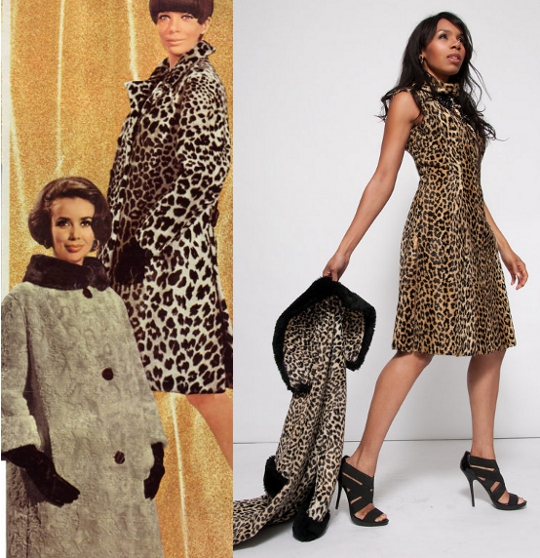 Credit: Fashion-pictures.com
Credit: Fashion-pictures.com
THE TREND: Spotted animal prints, particularly of the leopard variety. Produced in both real and faux versions on mostly coats, pillbox hats and dresses.
ITS INVENTION: The trend was born in the wardrobe of fashion icon and the most famous first lady of the 1960s: Jacklyn Onassis Kennedy.
For her tenure as leading lady of the White House and Queen of American fashion, Jackie hired designer Oleg Cassini as her courtier. His responsibilities were to suggest and design the pieces that would please both Jackie’s tastes and (whether intentional or not) set the trends for the American public. From the moment she stepped in the White House in 1961, the “Jackie Look” became the trend du jour for every American woman of the day.
According to Greathistory.com, Cassini is quoted as saying, “Many years ago, I did a fur coat for Jackie Kennedy. I suggested leopard to her. She loved the idea because those kinds of looks had not been seen for a long time.”
And so the leopard coat trend was born, and by the years of 1970s fashion leopards had become endangered species and the market had moved onto faux productions of the print instead.
ITS INFLUENCE: Wearing various types of animal fur for warmth and style was not a new idea in the ’60s. It was wearing specially patterned fur a la the spotted animal print that Jackie O introduced into the style consciousness of America.
Today you don’t only find leopard print on the shelves, but cheetah, jaguar, tiger, zebra, giraffe, cow and more. Not only does animal print rule supreme in variety, but on genres of fashion, too. It’s on wardrobe staples, accessories, shoes and lingerie.
Modern day fashion celebrities like The Kardashian Sisters have even released their own collection with a heavy emphasis on all-things-leopard for SEARS.
Since Jackie O wore her first leopard coat as designed by Cassini in 1961, wearing animal print is one of the most classic “default” fashion moves for a lady of any style personality. When in doubt, a girl can wear red. When feeling sophisticated, a girl can wear black.
But when wanting to feel fierce and fabulous? You bet a lady’s gonna wear leopard print!
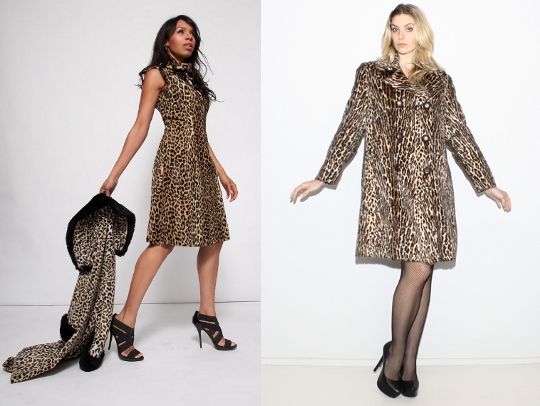
BUY THEM NOW: ’60s Leopard Print Dress by Erstwhilestyle on Etsy, $155 / ’60s Leopard Print Princess Coat by American Archive on Ebay, $168
[Back to the top.]
BELL BOTTOMS
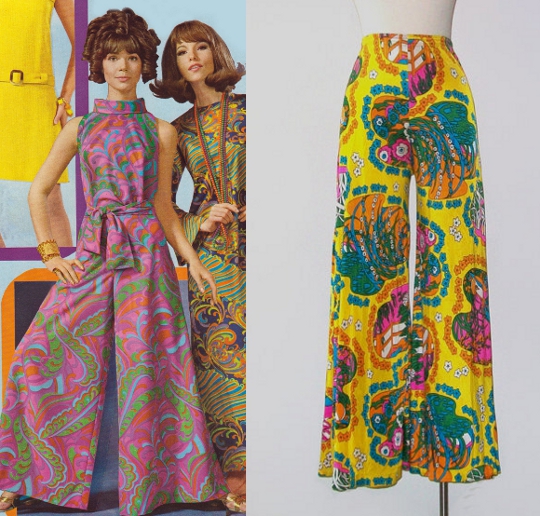 Credit: Fashion-pictures.com
Credit: Fashion-pictures.com
THE TREND: “Bell bottoms,” characterized by a snug fit at the thigh and a large bell-shaped flare beginning at the knee and ending at the ankle. Balloon pants (also called “loons”) are styled more like palazzo pants, widening and flaring at the hip in equal measure to the ankle.
ITS INVENTION: When you think of hippie fashion, the first thing that comes to mind are bell bottoms. Inspired by wide-legged pant styles first worn by British sailors in the 1800s, bell bottoms began with the hippie counter culture of the ’60s and slowly crept their way into mainstream youth fashion.
As part of their “counterculture consciousness,” the participants of the ’60s hippie movement often bought their clothing secondhand by shopping at thrift stores and charity shops. Oftentimes they’d find vintage military garb at secondhand army/navy stores.
The fact that women were beginning to wear trousers in the ’60s was an important reason why bell bottoms and balloon pants caught on via store-made versions. Rather than wear the more fitted pants of the male sect, women wore these looser, more feminine styles as fashion compromises.
Always in search of fresh inspiration, contemporary ’60s fashion brands adopted the hippie’s anti-society statement and reproduced its rebellious fashion statement into a mainstream trend.
ITS INFLUENCE: Bell bottom and wide-legged trouser revivals have occurred numerous times across the history of fashion, but the most influential point is that it set the stage for the future of pants altogether. It wasn’t until the ’60s that wide-legged pants were worn by men for the everyday, and that pants were considered appropriate (although still controversial) for the average woman to wear in formal settings.
Without the bell bottom, the denim trend may have had a tougher time becoming the default style choice of Americans today. By introducing a casual pair of trendy pants into the closet of every American youth, bell bottoms made “cool comfort” acceptable to wear all day, everyday.

BUY THEM NOW: ’60s Neon Bright Balloon Pants by Nick & Nessies on Etsy, $36 / ’60s Style Made-to-Order Bell Bottoms by Love Clothing on Ebay, $95
[Back to the top.]
KNEE-HIGH & THIGH-HIGH BOOTS
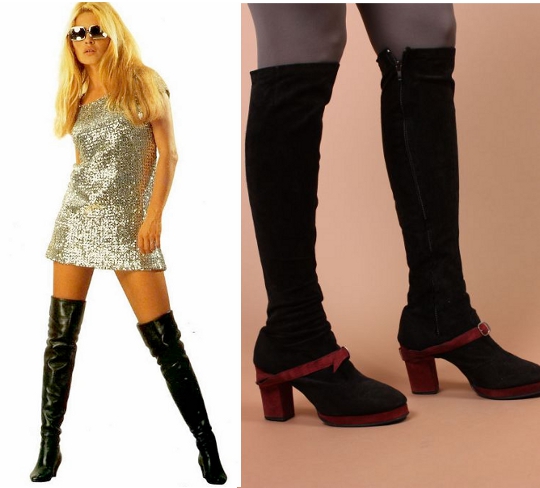 Credit: Fashion-pictures.com
Credit: Fashion-pictures.com
THE TREND: Knee-high boots and thigh-high boots with chunky heels. Also, “go-go” boots which were characterized as mod style boots usually of white synthetic leather/vinyl material.
ITS INVENTION: Prior to the ’60s, boots worn above the ankles were merely purchased for utilitarian purposes. First worn in the 20th century teens, the calf-length boot was conveniently chic because it was a practical way to walk about town without street sewage, dirt and grime caking itself onto a woman’s shoe or skirt/dress hem.
The above-the-ankle footwear style fell out of favor around the same time street cleaning was becoming more common and transportation opportunities grew into greater variety.
No longer did men and women walk the dirty streets, but rather took buses, trains and trolleys for public transportation to and from their desired destination. As a result, the utilitarian need for such a practical piece of fashion faded away, and so did the popularity of the boot itself.
It was in the ’60s that the calf to knee-high boot gained ground amongst women once again, this time embraced as an object of high-fashion cred thanks to the influence of designer Beth Levine. She literally created the “sexy boot silhouette” by cutting away extra fabric to reveal more of the foot’s natural shape.
Beth can’t be credited a the true “inventor” of the fashion boot (It was Yve Saint Laurent’s 1963 collection of knee-high leather boots that put the trend on the decade’s fashion map) but rather as its messenger to the masses. “These Boots Are Made for Walkin” songstress Nancy Sinatra wore a pair of Beth Levine boots for her song’s publicity shot, and as soon as the images were released to the masses Saks 5th Avenue sold out of the style and shortly thereafter opened it’s own boot department called “Beth’s Bootery.”
When Mary Quant popularized the mini skirt, these rising hemlines provoked another reason for the knee to thigh-high boot trend: The need for coverage of the leg for warmth, protection and (ahem) skin-showing compromise!
Thanks to the development of synthetic technologies in the ’50s-’60s, synthetic leather (plastic and vinyl materials) was quickly gaining grounds as the more desirable, cheaper alternative to leather. It was in 1967 — just as the trend of the mini skirt was rising (pun intended!) — that the vinyl over-the-knee boot became a fashion statement, as shown on sex kitten and ’60s fashion icon Brigitte Bardot, pictured above.
Mary released her own line of boots made from faux leather and sold for a cheap penny, thus making this footwear trend accessible to the middle class fashion conscious masses.
ITS INFLUENCE: When Nancy Sinatra sang “These boots are made for walkin’, and that’s just what they’ll do” no one knew just what she really meant. But as we reflect back on the boot trend of yesterday, we see that the crossover from purely functional (just walking) to purely fashionable (walking all over you, as Nancy sang) was a huge mark in how the rest of fashion would grow and adapt to this ever-evolving world.
A girl isn’t a girl today without a pair of knee-high boots in her closet. And like the ’60s, we’ve taken the utilitarian purpose and adopted it into its own unique style, as seen with riding boots (equestrian style), duck boots (galoshes) and Western boots (cowgirl boots).
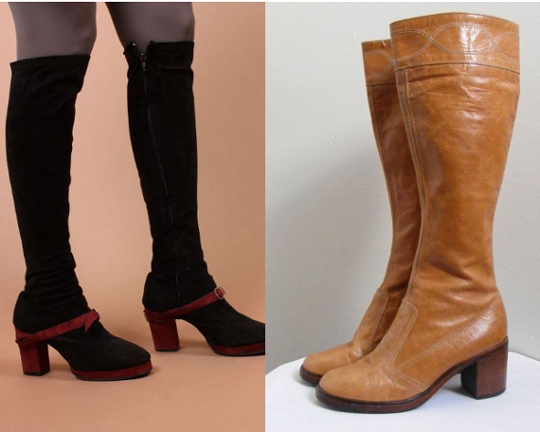
BUY THEM NOW: ’60s Black Suede English-Made Boots Size 9 by Mint Mall Store on Ebay, Bid Now! / ’60s Knee High Leather Boots Size 7 by Vintage Girl Ore on Ebay, $129
[Back to the top.]
THE EMPIRE WAIST
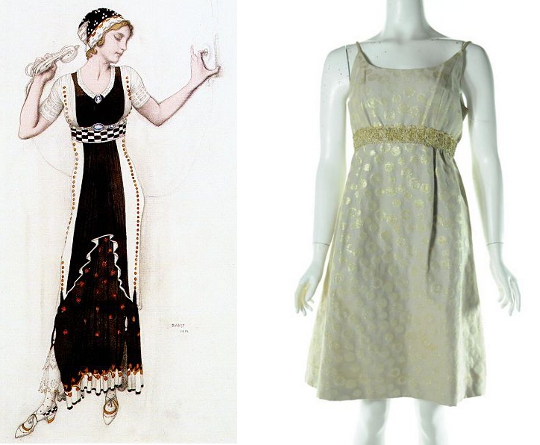 Credit: Wikipedia Commons
Credit: Wikipedia Commons
THE TREND: The empire waistline, a ’60s dress silhouette defined by a produced, defined waistline positioned higher than the natural waist on a female’s body. The empire waist typically rests immediately below the bust, which accentuates the body’s length giving its wearer a longer, leaner frame.
ITS INVENTION: The “empire” in empire waistline descends from the trend’s birthplace: During the “First French Empire,” the time of French global domination during the 19th century.
While the word “empire” is inspired by France, the “waist” part was created by a royal lady of British birth who lived during the First French Empire: Emma or “Lady Hamilton” who can be credited with the empire waist’s first “mainstream” design.
She designed dresses of this high-waist effect for use as a model and artistic muse. Her modeling fame influenced 19th century fashion to adopt the empire waist into its designs where it would remain until the hourglass figured gained trend traction once again in the early 1820s.
So why the empire waist in the 1960s? Well, like 1920s drop waist dresses, the empire dress represented an anti-conformist attitude to how a woman was supposed to dress.
The hourglass figure of the ’50s had dissipated along with its constricting, body-smashing corsets. The empire waistline was adopted by high-fashion designers in the ’60s and translated into ready-to-wear formal fashions for the everyday woman.
It wouldn’t be until the ’70s that the empire waistline gained ground in casual wear dresses, too.
ITS INFLUENCE: Today, the empire waist is every girls’ go-to dress silhoutte when she’s feeling fat, frumpy and not-so-fine. But ironically, these negative thoughts of self-loathing were not the inspiration behind the empire waist for both its inventor Emma “Lady Hamilton” or that of ’60s designers!
The empire waist was born because during its tie of birth, fashion was flexible to change. It was a practice of innovation and experimentation, not a creation to conceal the beautiful bodies of women.
Today the empire waist finds its way into fashion every season. Its’ a style that’s most commonly found in vintage ’70s maxi dresses, a trend continually reproduced for mainstream fashion purposes.
While the empire waist originated in high-fashion and formal wear of the ’60s, modern fashion has welcomed the empire to reign in its casual summer collections appropriate for casual weekends involving everything from a beach vacation getaway to a flexible, feminine look whilst grocery store shopping.
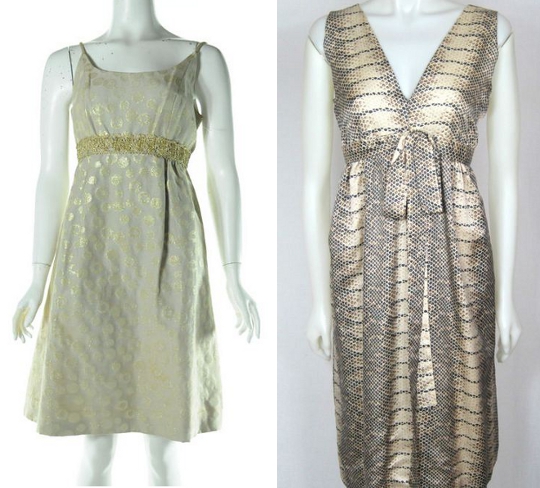
BUY THEM NOW: ’60s Empire Waist Mini Dress by Fashion Avenue NYC on Ebay, $53.99 / ’60s Empire Waist Python Print Dress by Vintage A La Mode SF on Ebay, $275
[Back to the top.]
NO WAIST
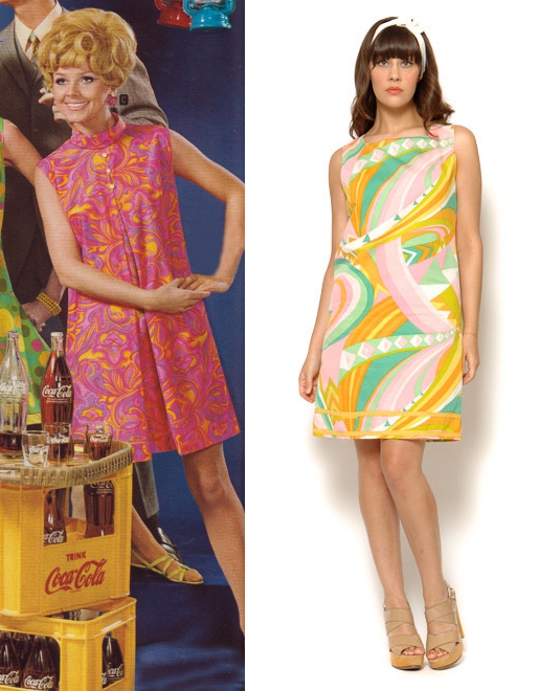 Credit: Fashion-pictures.com
Credit: Fashion-pictures.com
THE TREND: The shift, tent or trapeze, defined as a waist-free dress that sits freely on the body in an A-line, slightly flared to the knee silhouette.
ITS INVENTION: The revolutionary styles of the ’60s popularized two fresh “waist” trends: The high-waist defined “empire” waistline and the come-as-you-are “waist free” no-waist line. The latter found fame during the ’60s with the introduction of the tent dress or trapeze dress because they resembled these triangular shapes.
The popularity of the waist-free dress silhouette was revolutionary in the ’60s because it failed to accentuate the female form in any sort of way — something that was only seen prior during 1920s fashion with the drop waist dress.
The waist-free body of the ’60s became a vehicle for geometric dressing, a trend influenced by space-age shapes and figures with futuristic appeal.
ITS INFLUENCE: While the mini skirt set the stage for all things shorter-than-short, the tent dress set the stage for what would become known as “babydoll” a la ’90s fashion. Babydoll dresses are like mini skirts in a dress combined with the shape of a ’60s waist-less tent dress. They’re not just shorter-than-short but free-and-free-flowing!
The use of “tent” as a dress descriptor has not caught fashion ground in recent years because the term “babydoll” is favored and used by the masses.
But no matter the name, the style is all the same: The tent dress of yesterday is the babydoll dress of today!
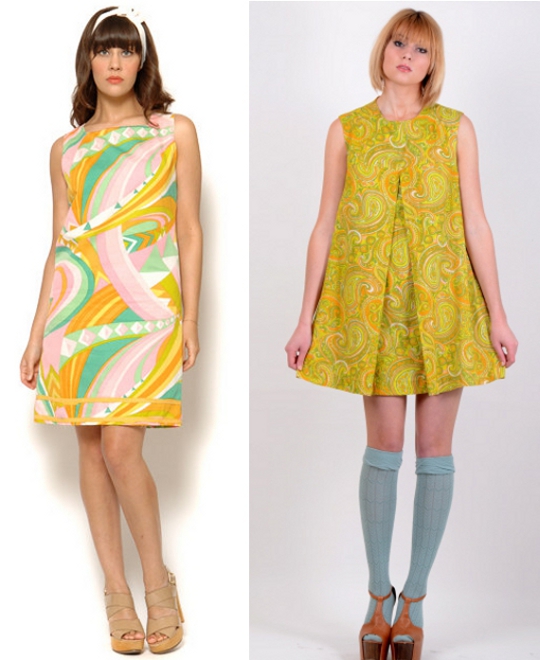
BUY THEM NOW: ’60s Waist-Free Shift Dress by Gravel Ghost Vintage on Etsy, $48 / ’60s Paisley Tent Dress by Electric Skinny on Ebay, $68
[Back to the top.]
THE TUXEDO JACKET
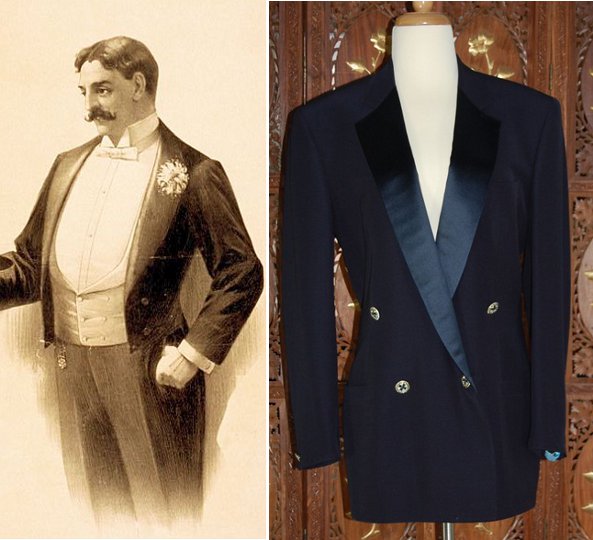 Credit: Wikipedia Commons
Credit: Wikipedia Commons
THE TREND: The tuxedo jacket for women, introduced as “Le Smoking Jacket” by designer Yves Saint Laurent in 1966. The tuxedo jacket was part of the “Le Smoking” pantsuit, a revolutionary introduction of a blazer with trousers tailored to flatter the female figure and intended to be worn in the same formal setting as a skirt or dress.
ITS INVENTION: While coined Le Smoking by YSL, this revolutionary fashion trend was modeled from a piece of formal wear only worn by men up until that point. Which is why it was so revolutionary in the first place: The androgynous styles of today were nowhere to be seen during the 1960s.
The seeds had been planted with the drop waist of the ’20s and the masculine cuts of the ’40s, but true credit is due to the man who was Yves Saint Laurent, who pushed the fashion boundaries for women toward Western society’s acceptance of androgynous styling for both sexes.
What YSL did differently was literally introduce a piece of men’s clothing into the stores to be sold exclusively for women. While Le Smoking jacket was marketed as a piece styled for the frame of a woman, it was still a clothing “style” considered for the male body only.
YSL creating the tuxedo jacket was like if a designer today created the man’s dress to be sold in stores: It rocked the fashion world and all the people in it.
ITS INFLUENCE: The tuxedo jacket set the stage for the future of womenswear-that-is-menswear: The pantsuit which would quietly emerge in the ’60s, proliferate in the ’70s and roar in the ’80s; into the Annie Hall inspired androgynous styles of the ’70s and reincarnated as a “minimalist” trend of the ’90s as inspired by the no frills simplicity of menswear.
In one simple statement, the adoption of the Le Smoking jacket in fashion allowed for a future where women didn’t have to wear pretty girlie dresses to feel feminine. Today a girl can wear her boyfriend’s blazer and still feel sexy — and she has YSL to thank for that.

BUY THEM NOW: ’80s Versace Tuxedo Jacket by PSpecial5 on Etsy, $157.50 / ’80s Tuxedo Jumpsuit by Persephone Vintage on Etsy, $85
[Back to the top.]
THE PANTSUIT
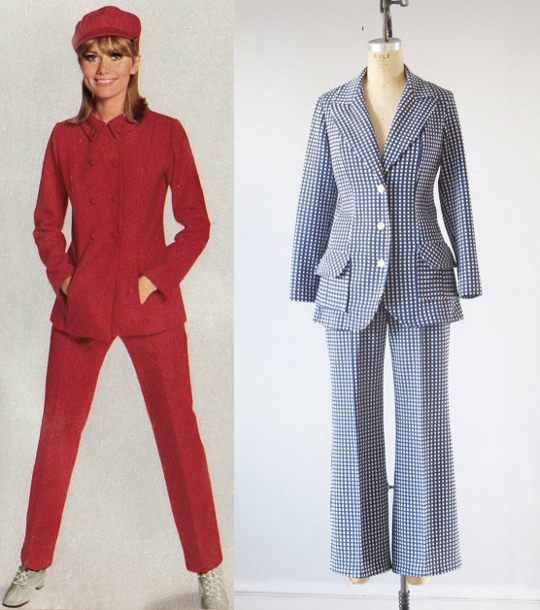 Credit: Fashion-pictures.com
Credit: Fashion-pictures.com
THE TREND: Pantsuits, the pairing of slacks and a blazer as modeled off men’s suits but worn by women for casual, work and formal wear.
ITS INVENTION: Invented as a mainstream “trend” in the ’60s by Yves Saint Laurent and André Courrèges, the pantsuit was a controversial fashion piece of the day and as some will argue, remains so in particular environments today.
While Courrèges pioneered the “trend” of trousers with his trouser-suit in 1961, it was YSL who pushed the idea onto fashion buyers in 1966, when he introduced the “Le Smoking” pantsuit into his collection for the fall/winter season. The suit included a tuxedo style jacket and what fashion reporters coined “city pants” for the trouser-pants.
From the its humble beginning in the ’60s through even today, pantsuits are a controversial fashion staple for women.
Soon after its introduction in the late ’60s, women wearing a pantsuit at restaurants were sometimes refused service. According to Paperpast.com, the story goes that:
“The unacceptability of trouser suits in many elegant restaurants continued to put off the press. The story went around of a trousered client who was regretfully refused admittance by the headwaiter of a well-known London restaurant and who, by way of reply, retired to the ladies’ room, removed her trousers, presented herself anew in her mini-length suit jacket, and was smilingly led to her table.”
Actresses and ’60s fashion icons like Katharine Hepburn wore pantsuits without apology, thereby paving the way for the democratization of fashion between men and women for today.
ITS INFLUENCE: While most hardly blink an eye at a woman wearing a pantsuit today, the issue of “should she wear trousers” remained until the 1990s, when the US Senate finally allowed woman senators to wear pantsuits during sessions of Congress.
It’s unbelievable to think that it wasn’t so long ago pantsuits were considered a fashion no-no in the work place, and that women were being discriminated against because they chose to illustrate those two things we’re all born with called “legs” via the trouser.
While bold, big blazers reigned supreme in the era of ’80s power suiting, most women of that lady-in-charge-era still wore skirts below their football sized shoulder pads.
Today, more conservative institutions like banks, government agencies and law firms still occasionally snub the sophistication of the pantsuit for women. Depending on where you live in the United States, you still may prefer wearing a skirt to work for fear of your fashion statement becoming water cooler gossip.
Today, the pantsuit continues to appear on the catwalk in fresh, feminine styles that flatter the figure and embrace modern trends. Cut in various styles, fits, and colors, no two pantsuits are ever created alike. While a man’s pinstripe suit can only take on a handful of variations, a female’s pinstripe suit can come in any color, any cut and any trouser-type/blazer-type coordination.
The possibilities are limitless and thanks to the ’60s, woman can comfortably say that they wear the pants, too.
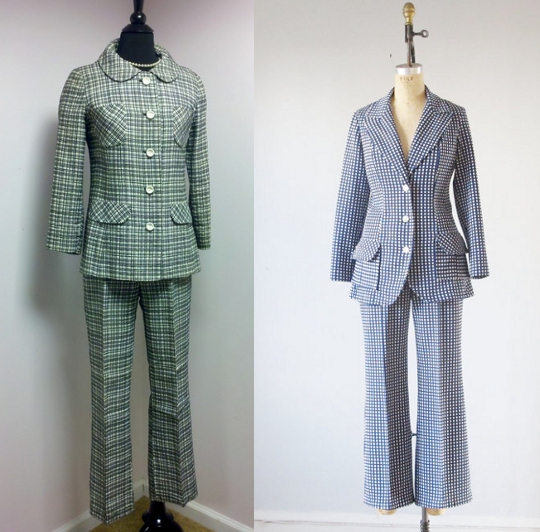
BUY THEM NOW: ’60s Black & White 3-Piece Pant and Skirtsuit by Viva La Vintage Shoppe on Etsy, $65 / ’60s Blue & White Checked Pantsuit by Studio Nostalgia on Etsy, $44.99
[Back to the top.]
MILITARY STYLE
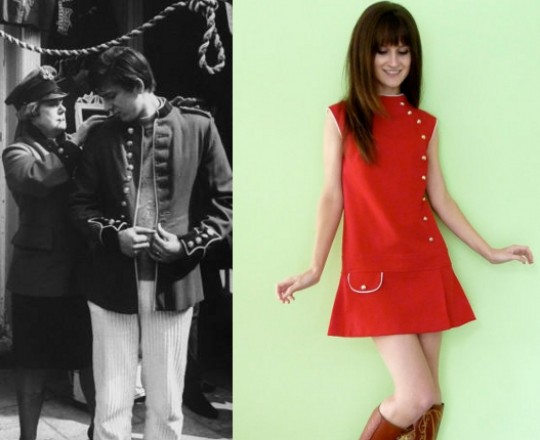 Credit: Wikipedia Commons
Credit: Wikipedia Commons
THE TREND: Military-style fashion, characterized by oversize gold buttons, high collars, epaulets and royal purples/blues/reds as inspired mostly by traditional United Kingdom and Hungarian “Hussar” uniforms.
During the 60s, military-style was infused into more traditional clothing like overcoats and capes, but also (shown above) used to decorate feminine womenswear, too.
ITS INVENTION: The military style trend in mainstream fashion of the ’60s can be attributed to the secondhand shopping habits of those swinging London hipsters known as mods.
Much like the hippies shopped thrift stores to discover the vintage navy uniform of bellbottom trousers in the ’60s, London’s swinging “mod” culture shopping the secondhand stalls of the city’s famous street markets discovered a surplus of previously owned military fashion.
So when the mod squad attacked the stalls of Portobello Road, Camden Market and Spitafields flea markets, their discovery of decorative pieces of military wear fit with their intent to dress as anti counterculture as possible: What better irony than to wear the pieces representing the government’s and society’s restrictive ideals they were fashionably rebelling against?
Like bell bottoms, the proliferation of military-style in mod counter trickled its way into the mainstream. UK bands who originated from the mod culture introduced the style to mainstream UK/American fans as their prominence rose. One such famous musician who often dressed in military garb was The Rolling Stones’ front man Mick Jagger.
ITS INFLUENCE: The re-emergence of military style hit fast fashion when it hit the runways of popular designers in the 2000s, most recently seen in the 2010/2011 fall-winter womenswear collections.
Military style is another example of how androgynous dressing can be achieved in a variety of ways, and wearing military-inspired clothing is just one of them. The cuts and characteristics of a military jacket, cape or coat are decorative and slenderizing so if anything, the inspiration behind military fashion is more “peacock” in nature and therefore comfortable for the average girl to wear without feeling overly masculine.
While bottoms have not made a return into men’s closets since the ’70s, the military look remains a staple on the menswear runways. It’s the best example of a trend from the ’60s that’s influenced fashion of both sexes.
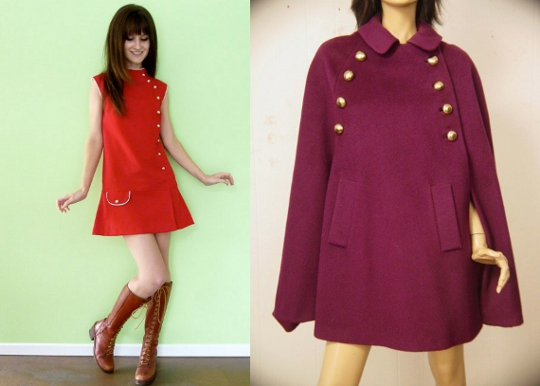
BUY THEM NOW: ’60s Red Mod Military-Style Mini Dress by Metric Mod on Etsy, $76 / ’60s Mod-Style Purple Cape by Party Store on Ebay, $75
[Back to the top.]
PATTERNED TIGHTS
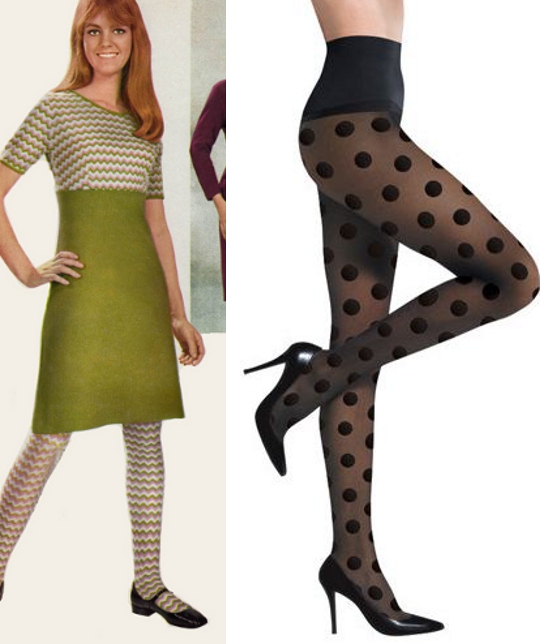 Credit: Fashion-pictures.com
Credit: Fashion-pictures.com
THE TREND: Printed novelty tights decorated with stripes, polka dots and various colors, shapes and designs.
ITS INVENTION: The first patterned tight was introduced to fashion buyers in the late ’50s — but like so many other revolutionary trends (the knee-high boot and mini skirt are examples), the “tattooed” leg effect was snubbed upon and wouldn’t be embraced by buyers until the emergence of the mini skirt.
When the legs of young ladies were bared to the elements of mother nature, a girl needed to protect her “more” exposed leg with something as funky and stylish as the mini skirt she was sporting. Enter the patterned tight, which adopted the vibrant and bright motifs of the mod ’60s.
ITS INFLUENCE: Patterned tights still rule the wardrobes of today’s fashion-forward youth.
Girls in their teens and ’20s pair funky patterned tights as a pop of color that either plays as an attention-grabber or as a strategic styling tool to create a tone-coordinated outfit. The “color-blocking” trend of seasons past and current has also influenced the steady trend of colored and patterned tights.
Patterned tights are so popular that sites like We Love Colors and Peek Brooklyn, along with department store brands like Hue focus exclusively on the tights market.
The patterned tights trend of today is a lot like the legging trend of the ’80s — every girl has to own at least one (or a dozen) options to pair with every look!
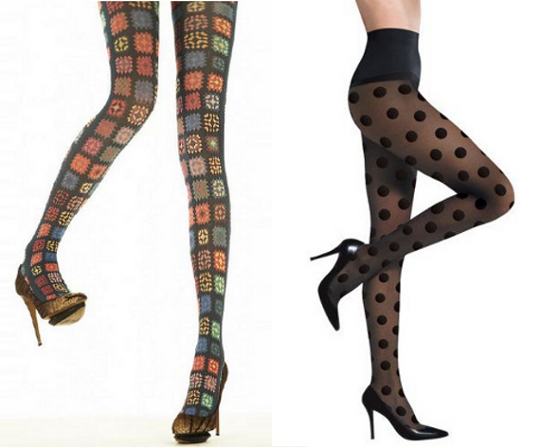
BUY THEM NOW: Vintage-Style House of Holland Crotchet Tights by Peek Brooklyn / Vintage-Style Polka Dot Tights by Peek Brooklyn, $32
[Back to the top.]
MORE ’60s FASHION HISTORY
Everything you need to know about 1960s fashion
TRENDS: How Trends of Today Were Influenced by the ‘60s
PICTURES: Photos of ’60s Fashion from McCall’s Magazine
HOW-TO: Style a Drop Waist Dress from the 1960s
SPRING: The Perfect Polka Dot ’60s Dress
STYLE: Your Easy Guide to ‘60s Bathing Suits
1960s FASHION FROM OUR PARTNERS
HISTORY: More on the ’60s from Paperpast
THE MINISKIRT: Its Complete History from Fashion-Era
1960s for Today: 7 Ways to Rock ’60s Fashion Now!
SPRING TRENDS: How the 1960s is Appearing for 2012
PLUS: ‘70s FASHION HISTORY
CELEBS: The 70’s Clothing Trends you can wear today
CELEBS: The Influences of ‘70s Celebs on Fashion Part I
CELEBS: The Influences of ‘70s Celebs on Fashion Part II
VIDEO: How I Styled a ‘70s Maxi Dress at the Manhattan Vintage Show
LOOKBOOK: How to Wear a ‘70s Pleated Plaid Skirt and ‘70s Velvet Shorts Styled for Today
PLUS: Why Midi Skirts Angered Women in the ‘70s

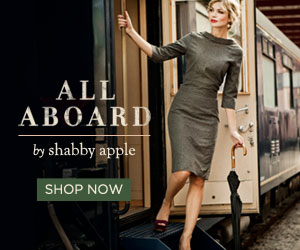
Style is so cyclical! Can we invent ANYTHING new that hasn’t been done before? Perhaps Lady Gaga does, but I’m not really interested. LOL
Great post chica!!
Lady Gaga definitely does invent new trends! She will be a vintage icon in a few decades, good call Carmen! XO
stfu
I love this Sammy!Nothing is new under the sun, its all how we will re-invent our favorite trends of the era in our “own fashion”. I personally love the patterned bright colored tights trend right now while wearing a classic mini..and what the heck..throw in some leopard print while we are at it! I love these photos and the trends you picked to focus on are so many of our favorites!
Brande, did you check out We Love Colors site? Every patterned tight lovers’ dream come true!
Those are nice kinds of clothings. I like it
:-) thank you for reading & commenting Tifanny!
Tifanny, thank you for reading the article to learn more about ’60s fashion! Hope to see you here again soon. XO
I love the 60s! (Not the polyesters so much….) but the colors and funky styles were great. It was like a big party :-)
xoxo
Some Like it Vintage, I want a ’60s lovin’ party. and a pony. and tie dye tools! let’s rock it. tie dye ponies?! XO
Hey Some Like it Vintage! Sammy Davis Vintage thinks that ALL SHOULD Like it Vintage! Just checked out your site and I think we should get together and throw a ’60s bash. XO
WE SHOULD SO HAVE A 60S BASH
RELIVE THE MOMENT
I’m all about it! ’60s party time!
Many eyeglasses today Warby Parker etc. are inspired by the 60’s designs. Cat eye glasses, men’s Nerd glasses etc..
This is so true! An article on vintage-inspired eyewear is a great idea. What are your favorite brands besides Warby Parker? Thanks!
This is very interesting, You are an overly professional blogger. I have joined your rss feed and sit up for looking for more of your excellent post. Also, I’ve shared your site in my social networks
Hi Racquel! Thank you I appreciate this so much! I am releasing a post on each decade which focuses on the trends. My first will be on the ’60s this week, so be sure to look for it. I think you will enjoy it very much! Thank you!
This Isnt Cutee
THis IS UGLY
Your Soo Beautiful Jackie ;)
Ooh Thanks <3 Soo Are You ;)
OMG luv the dresses y dont the 60s style come back !HEY GOOD IDEA !
WOW look at all the neet cloths luv it 60s style come back
Wow I have a ideal why don’t the awesome styles come back:)
hahaahahahahahaha I LOVE THAT DRESS:)
Loved all the the sixties clothes. It was great wearing them. Never been a fashion to beat it.
Hope it comes back so younger generation could enjoy it also.
Loved all the happy colours. 68 now. But have some great memories.
Thanks for posting all of these memories.
Cute*